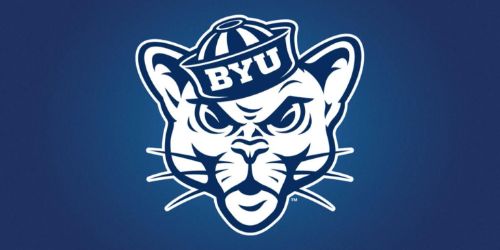Brigham Young University’s (BYU) brand identity is made up of a number of symbols, from the BYU monogram to the sailor cougar. For starters, the BYU logo shows how the school is helping to give the next generation strength and self-confidence. And because of what they learn at university, students become full-fledged members of society with strong principles and ideals.
In the middle of 2019, the university started a big brand research project that includes interviews, focus groups, and a perceptions study, among other things. But in the meantime, let’s go over what the logo represents, its evolution over the years, and all you should know about the logo.
What Exactly is BYU?
Brigham Young University is a university in the state of Utah. It is also known colloquially as the “Y.” It was previously known as Brigham Young Academy.
BYU Logo: Overview of the Brand
BYU (Brigham Young University) is a private educational institution supported by the LDS Church and operated under the Church Educational System (The Church of Jesus Christ of Latter-day Saints). It is a doctoral university with good research results, and the Northwest Commission on Colleges and Universities has approved it.
The university not only prepares bachelors in 179 disciplines but also offers doctorate and master’s level education in 26 and 62 programs, respectively. Furthermore, the university maintains branches in Salt Lake City and Jerusalem. The school also has a sports club named the Cougars, which participates in NCAA Division I.
BYU Logo: Symbols
The Primary Logo
The main BYU logo is the navy blue BYU monogram. It’s written in a legible font with delicate serifs.
The Secondary BYU logo
Stretch Y
The logo is a huge letter “Y” inside a navy ellipse. It is only used as the athletics logo, and it is usually coupled with the block BYU. The “Y” on the mountain inspired the logo.
Block BYU
The initials of the university are written in a collegiate font. The letter “Y” is higher than the letters “B” and “U.” The emblem can be used as an athletic logo or for student life events.
Block Y
The design is the same as the Block BYU logo.
BYU Logo History
Brigham Young University, named after its founder, first appeared considerably before the formal date. It dates back to 1862 when patron Warren Dusenberry established a school at Cluff Hall, one of Provo’s brick buildings off the main streets. After that, the school moved closer to the center of the city and became a branch of the University of Deseret. However, financial constraints prevented him from working actively, and he closed.
Brigham Young, the leader of the LDS Church, handed the institution to a board of trustees in the hope of revitalizing it in 1875. Brigham Young Academy opened its doors and began instructing pupils the next year. It was split into two separate but eponymous organizations in 1903: Brigham Young University and Brigham Young High School.
To help the institution, the administration purchased several acres of land and began construction on the first academic building. It is now a large-scale construction project with numerous buildings, both educational and residential. Her identity is multifaceted, with various distinguishing features.
The academic emblem is a variation on the official seal in that it uses the same features but in a different arrangement. BYU University’s name is printed in a similar font. It is at the very top, separated by a tiny line. The entire name of Brigham Young University is listed below the abbreviation. The inscription is divided into two lines: the first two words are huge, while the third is little. The business color palette – dark blue on a white background – is also retained.
The BYU Seal
The official seal of BYU is a spherical emblem. It is adorned in the style of a rondel and is divided into many portions by rings. There is an abbreviation in the center: “smooth, bold, with thin serifs.” Two little silver stripes outline the writing above and below. The word “founded” is written in capital letters above it. The year the university was founded is listed here: “1875.” Then there are two narrow lines separated by a wide blue box containing text. There is information on the educational institution’s full name and location. Text pieces are separated by little diamonds.
BYU Logo Evolution
Brigham Young Cougars is a sports league with 21 teams that is part of Brigham Young University, which was founded in 1875. Swimming, volleyball, gymnastics, basketball, football, golf, and other sports are represented by 11 men and 10 women. The organization is headquartered in Provo, Utah.
The Brigham Young University sports department logos all have one thing in common: writing. The first is an abbreviation, the second is a full and helpful piece, and the third is just a single letter. Furthermore, the symbols are classified into two conditional groups: with and without a puma. The university mascot is not used in the current logo because it would make it too hard to draw.
1969 – 1998
The Cougars’ inaugural logo features a puma, the university’s mascot. The predator is made in contour, which means that the edges are made with a solid blue stripe and there are no other colors inside. This makes the predator white. She sneaks up on the university’s truncated name, carefully placing her paws: one leg is on “B,” two on “Y,” and one more produces a depression in “U.” The wild cat’s head has fallen. The mouth is wide open. The lengthy tail is relaxed. The ears have been flattened. The letters it contains have contour outlines as well, but with the core section filled in, they have bold lines just on the exterior, producing a solid frame. The animal’s picture is contoured. Symbols, on the other hand, have a double border and are fully colored.
1999 – 2004
The Cougar’s drawing style has altered since the redesign; it now has more realistic features. The animal is pictured in the highlands as sharp triangles and multi-structured peaks. The wild beast’s body is muscular and almost crushed to the ground, as if ready for an attack jump. An open mouth with sharp fangs, a frowning forehead, elevated ears, and a stare all indicate a willingness to charge at the enemy. Her gaze is fixed on a single location, and her ears are lifted. Behind the crawling moves, it is clear that there is a lot of power, endurance, strength, and will. The name of the sports team, “Brigham Young University Cougars,” is ungrouped into three lines below. Each section has its own font. Brigham Young has a high serif and a thin white line, while the Cougars have a wide chopped line.
2005 – Present
There are no mountains, cougars, or even a name in the contemporary logo. It was given to the department following a redesign aimed at simplifying personal symbolism. It is legible on any medium and looks nice as a print on clothing or sporting equipment. The letter “Y” takes up the entire space of the blue oval. Because her massive prototype is built into a mountain near one of the campuses, she, too, serves as a mascot for the educational institution. This sign represents the name of the university’s founder, Young. The top serifs are arranged to form a downward-pointing arrow in negative space.
BYU Logo Font and Colors
Its moniker encompasses Brigham Young University’s complete identity. The text can be found in sporting emblems, academic press, and the university’s logo. Blue and white color schemes are very popular. They are enhanced with gold in some forms.
According to university management, three types of typefaces are permitted in brand names: Requiem, Vitesse, and Ringside. It is used based on the function of the symbols. The main logo is a sharp, thin serif typeface, whereas the sport’s insignia is wide, flat, and filled with big serifs. The college palette is consistent: white and two hues of blue (base and dark) are used throughout.
When Did BYU Logo Change?
BYU rebranded completely in 1999, introducing several new logos. Fans didn’t like the addition of tan to go with the darker shade of blue, and they didn’t like the new logos either, but once the Cougars officially rejected the old look, they were left without an official secondary mark.
“The logos we had weren’t really resonating with the audience,” said Adam Parker, licensing and trademark manager at Brigham Young University. “We approached a design firm about developing a new one, but then we discovered, ‘Hey, we have one right under our nose.'”
A visible secondary logo hasn’t always been necessary for BYU’s football program, as its classic design doesn’t require a logo other than the Stretch Y. But now that a secondary mark has been made official, the uniforms might be changed.
Is the BYU Logo Legally Protected?
The provision of rights to a third party who wants to link itself economically (for profit or not) with an institution through the use of trademarks, names, logos, symbols, and slogans is known as licensing.
IMG Collegiate Licensing (IMGCL) is working with BYU to help protect, manage, and promote the BYU brand. BYU owns the trademarks and icons and works with IMGCL to do this.
Anyone who intends to use BYU’s names or iconography must get a license. Licensing safeguards the institution’s brand, reputation, and image by allowing only appropriate uses and ensuring that only high-quality items are connected with it.
Is Coffee Prohibited at BYU?
BYU is a private university owned by The Church of Jesus Christ of Latter-day Saints, whose general membership has pledged not to use alcohol, tobacco, coffee, or tea. Because of this, you can’t smoke or drink alcohol, coffee, or tea on the BYU campus, but you can drink other caffeinated drinks. Those who wish to smoke must do so outside of campus. Many neighborhood establishments sell alcohol, coffee, and tea.
Is It Acceptable to Wear Tattered Jeans to BYU?
Shorts, dresses, and skirts must be at least knee-length. Jeans, pants, or shorts, as well as other apparel that is worn through, frayed, damaged, or has holes in it, even if the holes are below the knee, are not allowed.
Shirts are required to be worn at all times in public venues on campus. Clothes must have sleeves and cover the shoulders, back, and stomach. Form-fitting, exposing, sheer, or low-cut clothing is not permitted. Messages and images on clothing must adhere to The Church of Jesus Christ of Latter-day Saints standards. All public campus areas require the wearing of shoes. Slippers and flip-flops are permitted.
Tattoos are not permitted. Students with tattoos must cover them at all times. It is against the Honor Code for students to get fresh tattoos.
Is Alcohol Prohibited at BYU?
As a condition of enrollment or employment, the university requires all students and staff to follow the Church Educational System Honor Code (Honor Code), which includes a personal promise to stay away from alcohol, tobacco, tea, coffee, vaping, and drug abuse, both on and off campus. It is illegal to possess, use, or distribute illegal substances or alcohol.
The Drug-Free Schools and Communities Act Amendments of 1989 say that a higher education institution must certify that it has adopted and put into place a program to stop students and staff from illegally possessing, using, or distributing drugs and alcohol in order to get federal funds from any federal program. In addition to the Honor Code, the university has made this Drug-Free School Policy so it can follow the law and help society fight drug and alcohol addiction.
This Drug-Free School Policy should not be confused with the university’s Drug-Free Workplace Policy, which is meant to comply with the Drug-Free Workplace Act of 1988 and keeps an eye on the workplace environment of university workers doing federally funded research.
NYU History
Origin
The Brigham Young University in Provo, Utah, is a private research university also known by its initials, BYU, and the nickname “The Y.” Brigham Young, a religious leader, started it in 1875. The Latter-day Saint movement (LDS Church) backs it.
At BYU, you can study things like liberal arts, engineering, agriculture, business, physical and mathematical sciences, nursing, and law, among other things. There are 186 majors for undergrads, 64 for graduates, and 26 for doctorates.
On the main Provo campus, there are roughly 11 colleges or schools, with several having their own admissions requirements. The Church Educational System (CES), which is the parent group, also pays for sister schools in Hawaii and Idaho. The main campus is in Jerusalem. The Northwest Commission on Colleges and Universities has granted accreditation to the school.
Almost every student at BYU is a devout follower of the LDS faith. Students at BYU sign an honor code that requires them to act in ways consistent with Mormon teachings. These include being honest in their schoolwork, being kind to faculty and staff, being clean and well-groomed, not having sexual relationships outside of marriage, not dating people of the same gender, and not using illegal drugs.
Read Also: ALLSTATE LOGO: The Story Behind Allstate’s “Good Hands”
No matter what their major is, all undergraduates must complete the LDS Church’s religious education requirements. Nearly half of BYU students have lived outside the United States, and 65% speak a second language; this is likely at least in part due to the church’s emphasis on missionary service. The institution also frequently offers classes in 63 different languages.
The BYU Cougars are the umbrella brand for all of the university’s varsity sports programs that compete at the Division I level of the NCAA. Their football team competes in the Division 1 Independent Football Championship, while the rest of their sports teams are members of the West Coast Conference or the Mountain Pacific Sports Federation. Twelve NCAA championships and twenty-six more titles were won by BYU sports teams that were not NCAA-affiliated. BYU officially joined the Big 12 Conference in the 2023–24 academic year after accepting an invitation on September 10, 2021.
The History
In 1862, Warren Dusenberry opened a school in Provo’s Cluff Hall, a famous adobe building at the northeast corner of 200 East and 200 North. This was the start of Brigham Young University. After the school ran into money problems, it was moved to the Kinsey and Lewis buildings on Center Street in Provo. These buildings were praised for their quality, and the school became the Timpanogos campus of the University of Deseret.
Brigham Young hinted in 1867 that a school would be built near Draper, Utah. On October 16, 1875, when money problems forced a second closure, he gave the land to trustees. This time, the school would remain open and become Brigham Young Academy. Therefore, many people consider October 16, 1875, to be the date that BYU first opened its doors.
It had been a long-held dream of Young’s to build a university dedicated to the Christian faith. “I wish to see an academy constructed in Provo… at which the children of the Latter-day Saints might obtain a decent education unmixed with the destructive atheistic influences that are found in so many of the higher schools in the country,” Young said.
Read Also: PAYPAL LOGO: Meaning, Font, History & Evolution
In the year 1876, on January 3, students first enrolled at Brigham Young Academy. Before Brigham Young’s preferred candidate, a German immigrant named Karl Maeser, arrived in April 1876, Dusenberry oversaw the school for a while. Maeser was in charge of the school when many famous people, like future Supreme Court Justice George Sutherland and Senator Reed Smoot, went there.
A university status was not granted until after Benjamin Cluff’s presidency ended. Before the school’s official adoption and sponsorship by the church on July 18, 1896, it was funded privately by members of the community. Cluff was fired as president of the academy after a series of strange management mistakes, but before he left, he suggested that the school be renamed Brigham Young University. Even though a lot of Board members said they didn’t agree with the idea, and some said the school was too small to be called a university, the motion was finally passed. Anthon H. Lund, an outspoken critic of the decision, was quoted as saying, “I hope their head will grow big enough for their hat.”
Read Also: PUNISHER LOGO: The True Meaning of the Controversial Logo, Revealed!!!
When Brigham Young Academy closed in 1903, it was succeeded by Brigham Young High School (BY High) and Brigham Young University (BYU).
The BY High Class of 1907 left their mark on the world by carving a massive “Y” into the side of a mountain not far from campus. George H. Brimhall was chosen as the new president of BYU by the Board of Trustees. At age forty, he finally finished high school. Not only that, but he could get things done and put on a show. As president, he worked with the city of Provo to buy 17 acres (69,000 square meters) of land for the young BYU in 1904.
The first building on the current campus, the Karl G. Maeser Memorial, was constructed in 1909, despite local opposition to BYU’s purchase of the land.
The notion of evolution caused a temporary problem during Brimhall’s presidency at BYU. It seemed at the time that the religious character of the school was at odds with this scientific premise. For the time being, the issue was put to rest when Church President Joseph F. Smith requested that evolution not be taught in church-run schools.
A middle ground between evolution’s scientific facts and the church’s dogma was found by students and teachers throughout time. Although some critics at the time labeled the institution as little more than a “religious seminary,” many of its students and alums went on to achieve tremendous success and became well-known in a wide range of areas.
Related Articles
- COFFEE STOCKS: 5 Best Coffee Stocks 2022 ( + pricing plan )
- PURDUE LOGO: Meaning, Citation and History
- 10 Best Church Management Software 2022: Free & Paid Options
- Boot Brands: The Comprehensive Best 2022 Picks.
- Boot Brands: The Comprehensive Best 2022 Picks.






